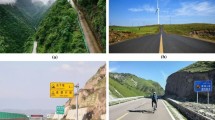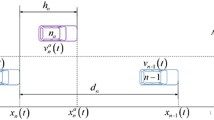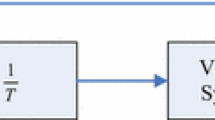Abstract
In the light of Konishi et al.’s car-following model, considering safe headway effect of the two preceding cars on the following one, a novel feedback control scheme in the discrete car-following model is proposed. The stability condition is analysed under which the traffic system is steady running. When our scheme is applied to the discrete car-following model, the stability region could be enlarged effectively. Through simulation, we can obtain the result that our model exhibits a better effect that suppresses traffic jams compared with previous congestion control methods, and simulation outcomes are consistent with the theoretical derivation results. Because of considering information factor of multi-preceding vehicles, our controller is useful for investigation of intelligent transportation systems.





Similar content being viewed by others
References
Chowdhury, D., Santen, L., Schadschneider, A.: Statistical physics of vehicular traffic and some related systems. Phys. Rept. 329(4–6), 199–329 (2000)
Naito, Y., Nagatani, T.: Effect of headway and velocity on safety-collision transition induced by lane changing in traffic flow. Physica A. 391(4), 1626–1635 (2012)
Tang, T.Q., Wang, Y.P., Yang, X.B., Wu, Y.H.: A new car-following model accounting for varying road condition. Nonlinear Dyn. 70(2), 1397–1405 (2014)
Nagatani, T., Tobita, K.: Vehicular motion in counter traffic flow through a series of signals controlled by a phase shift. Physica A. 391(20), 4976–4985 (2012)
Jin, S., Wang, D.H., Tao, P.F., Li, P.F.: Non-lane-based full velocity difference car following model. Physica A. 389(21), 4654–4662 (2010)
Yukawa, S., Kikuchi, M.: Coupled-Map modeling of one-dimensional traffic flow. J. Phys. Soc. Jpn. 64(1), 35–38 (1995)
David, J.L., Paul, S.A.: A nonlinear temporal headway model of traffic dynamics. Nonlinear Dyn. 16(2), 127–151 (1998)
Treiber, M., Kesting, A., Helbing, D.: Delays, inaccuracies, and anticipation in microscopic traffic models. Physica A. 360, 71–88 (2006)
Tang, T.Q., Li, C.Y., Huang, H.J.: A new car-following model with the consideration of the driver’s forecast effect. Phys. Lett. A 374(38), 1668–1672 (2010)
Tang, T.Q., Huang, H.J., Shang, H.Y.: Influences of the driver’s bounded rationality on micro driving behavior, fuel consumption and emissions. Trans. Res. Part D 41, 423–432 (2015)
Bando, M., Hasebe, K., Shibata, A., Sugiyama, Y.: Dynamical model of traffic congestion and numerical simulation. Phys. Rev. E 51(2), 1035–1042 (1995)
Jiang, R., Wu, Q.S., Zhu, Z.J.: A new continuum model for traffic flow and numerical tests. Transp. Res. Part B., Methodol 36(5), 405–419 (2002).
Xu, N., Shang, P., Kamae, S.: Modeling traffic flow correlation using DFA and DCCA. Nonlinear Dyn. 61(1), 207–216 (2010)
Tadaki, S., Kikuchi, M., Sugiyama, Y., Yukawa, S.: Coupled map traffic flow simulator based on optimal velocity functions. J. Phys. Soc. Jpn. 67(7), 2270–2276 (1998)
Yu, S.W., Shi, Z.K.: An improved car-following model considering relative velocity fluctuation. Commun. Nonlinear. Sci. Numer. Simul 36, 319–326 (2015)
Ngoduy, D.: Generalized macroscopic traffic model with time delay. Nonlinear Dyn. 77(1–2), 289–296 (2014)
Zhou, J., Shi, Z.K., Cao, J.L.: An extended traffic flow model on a gradient highway with the consideration of the relative velocity. Nonlinear Dyn. 78(3), 1765–1779 (2014)
Zhou, J.: An extended visual angle model for car-following theory. Nonlinear Dyn. 81(1), 549–560 (2015)
Zhou, J., Shi, Z.K., Cao, J.L.: Nonlinear analysis of the optimal velocity difference model with reaction-time delay. Physica A 396, 77–87 (2014)
Yu, S.W., Liu, Q.L., Li, X.H.: Full velocity difference and acceleration model for a car-following theory. Commun. Nonlinear. Sci. Numer. Simul. 18, 1229–1234 (2013)
Li, Y.F., Sun, D.H., Liu, W.N., Zhang, M., Zhao, M., Liao, X.Y., Tang, L.: Modeling and simulation for microscopic traffic flow based on multiple headway, velocity and acceleration difference. Nonlinear Dyn. 66(1–2), 15–28 (2011)
Tang, T.Q., Shi, W.F., Shang, H.Y., Wang, Y.P.: A new car-following model with consideration of inter-vehicle communication. Nonlinear Dyn. 76, 2017–2023 (2014)
Machado, J.A.T., Figueiredo, L.: Special issue on modelling and control of intelligent transportation systems (ITS). Nonlinear Dyn. 49(4), 443–444 (2007)
Konishi, K., Kokame, H., Hirata, K.: Coupled map car-following model and its delayed-feedback control. Phys. Rev. E 60(4), 4000–4007 (1999)
Zhao, X.M., Gao, Z.Y.: A control method for congested traffic induced by bottlenecks in the coupled map car-following model. Physica A 366(1), 513–522 (2006)
Han, X.L., Jiang, C.Y., Ge, H.X., Dai, S.Q.: A modified coupled map car-following model based on application of intelligent transportation system and control of traffic congestion. Acta. Phys. Sin. 56(8), 4383–4392 (2007)
Ge, H.X., Liu, Y.X., Cheng, R.J., Lo, S.M.: A modified coupled map car following model and its traffic congestion analysis. Commun. Nonlinear Sci. Numer. Simulat. 17(11), 4439–4445 (2012)
Ge, H.X.: Modified coupled map car-following model and its delayed feedback control scheme. Chin. Phy. B 20(9), 69–76 (2011)
Yu, H.M., Cheng, R.J., Ge, H.X.: Considering Backward effect in coupled map car-following model. Commun. Theor. Phys. 54(1), 117–122 (2010)
Ge, H.X.: Modified coupled map car-following model and its delayed feedback control scheme. Chin. Phys. B 20(9), 090502.1–090502.8 (2011)
Cheng, R.J., Han, X.L., Lo, S.M., Ge, H.X.: A control method applied to mixed traffic flow for the coupled-map car-following model. Chin. Phys. B 23(3), 030507.1–030507.8 (2014)
Herman, R., Montroll, E.W., Potts, R.B., Rothery, R.W.: Traffic dynamics: analysis of stability in car following. Oper. Res. 7(1), 86–106 (1959)
Acknowledgements
This work was supported by the China Postdoctoral Science Foundation (2014T70852 and 2015M572450), Fundamental Research Funds for the Central Universities (106112014CDJZR188801), Chongqing Postdoctoral Science Foundation Project (Xm201305 and Xm2015056), Scientific and Technological Research Program of Chongqing Municipal Education Commission (Grant No. KJ1503301), and Natural Science Foundation of Chongqing (cstc2016jcyjA0565) and the Key application projects of Chongqing(cstc2014yykf B30003).
Author information
Authors and Affiliations
Corresponding author
Appendix
Appendix
Firstly, according to the Jury’ stability criterion, \(\bar{{P}}_i (z)\) is stable if
We can get
There is the value of feedback gain k in Eq. (2), if the following condition is satisfied:
That is,
Therefore, the first condition for the feedback gain k for \(P_i (z)\) is given as
Secondly, consider \({\Vert {G_i (z)} \Vert }_\infty \le 1\), that is
Equation (6) is stable if the following equation is fulfilled.
Let \(z=\cos \theta +i\sin \theta \), Eq. (33) can be written as
Eq. (7) can be reduced to
Since \(1-\cos \theta \ge 0\) for arbitrary \(\theta \).
We consider
As \(1-\left| {\cos \theta } \right| <0\), Eq.(9) can be described as
If \(\;0.15-\alpha _i T+kT+\alpha _i r_i T^{2}>0\)
If \(\;0.15-\alpha _i T+kT+\alpha _i r_i T^{2}<0\)
If \(\;0.15-\alpha _i T+kT+\alpha _i r_i T^{2}=0\)
We can see that the above conditions (a)–(c) are equal to the conditions (i)–(iv) in Theorem 1.
Rights and permissions
About this article
Cite this article
Zheng, L., Zhou, T., Liu, W. et al. A new control method integrated into the coupled map car-following model for suppressing traffic jams. Nonlinear Dyn 88, 663–671 (2017). https://doi.org/10.1007/s11071-016-3268-1
Received:
Accepted:
Published:
Issue Date:
DOI: https://doi.org/10.1007/s11071-016-3268-1




